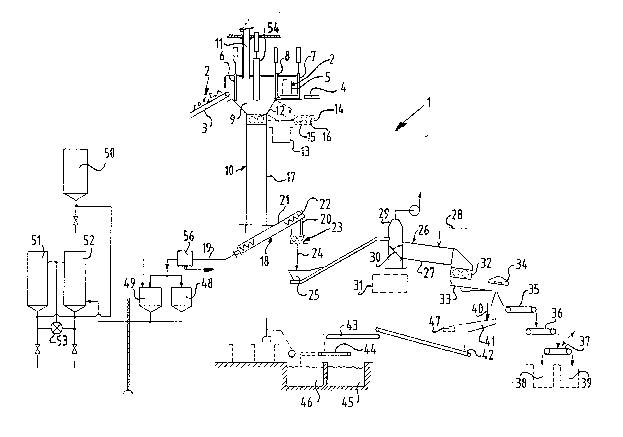Une partie des informations de ce site Web a été fournie par des sources externes. Le gouvernement du Canada n'assume aucune responsabilité concernant la précision, l'actualité ou la fiabilité des informations fournies par les sources externes. Les utilisateurs qui désirent employer cette information devraient consulter directement la source des informations. Le contenu fourni par les sources externes n'est pas assujetti aux exigences sur les langues officielles, la protection des renseignements personnels et l'accessibilité.
L'apparition de différences dans le texte et l'image des Revendications et de l'Abrégé dépend du moment auquel le document est publié. Les textes des Revendications et de l'Abrégé sont affichés :
| (12) Demande de brevet: | (11) CA 2059023 |
|---|---|
| (54) Titre français: | METHODE ET DISPOSITIF POUR LE TRAITEMENT DES DECHETS |
| (54) Titre anglais: | METHOD AND DEVICE FOR TREATING WASTE |
| Statut: | Réputée abandonnée et au-delà du délai pour le rétablissement - en attente de la réponse à l’avis de communication rejetée |
| (51) Classification internationale des brevets (CIB): |
|
|---|---|
| (72) Inventeurs : |
|
| (73) Titulaires : |
|
| (71) Demandeurs : |
|
| (74) Agent: | SMART & BIGGAR LP |
| (74) Co-agent: | |
| (45) Délivré: | |
| (22) Date de dépôt: | 1992-01-08 |
| (41) Mise à la disponibilité du public: | 1993-07-09 |
| Requête d'examen: | 1998-09-16 |
| Licence disponible: | S.O. |
| Cédé au domaine public: | S.O. |
| (25) Langue des documents déposés: | Anglais |
| Traité de coopération en matière de brevets (PCT): | Non |
|---|
| (30) Données de priorité de la demande: | S.O. |
|---|
P HP/LS/LR-1
ABSTRACT
The invention relates to a method for treating waste
comprising the steps of:
i) shredding the waste;
ii) separating liquid;
iii) subjecting the separated solid waste to a cold treatment;
and
iv) separating product remnants,
and to a device for treating waste, comprising:
i) a shredder unit;
ii) a unit for separating liquid out of the shredded
material;
iii) a cold treatment unit for the shredded material; and
iv) a unit for separating product remnants.
Note : Les revendications sont présentées dans la langue officielle dans laquelle elles ont été soumises.
Note : Les descriptions sont présentées dans la langue officielle dans laquelle elles ont été soumises.

2024-08-01 : Dans le cadre de la transition vers les Brevets de nouvelle génération (BNG), la base de données sur les brevets canadiens (BDBC) contient désormais un Historique d'événement plus détaillé, qui reproduit le Journal des événements de notre nouvelle solution interne.
Veuillez noter que les événements débutant par « Inactive : » se réfèrent à des événements qui ne sont plus utilisés dans notre nouvelle solution interne.
Pour une meilleure compréhension de l'état de la demande ou brevet qui figure sur cette page, la rubrique Mise en garde , et les descriptions de Brevet , Historique d'événement , Taxes périodiques et Historique des paiements devraient être consultées.
| Description | Date |
|---|---|
| Inactive : CIB désactivée | 2011-07-26 |
| Inactive : CIB dérivée en 1re pos. est < | 2006-03-11 |
| Inactive : CIB de MCD | 2006-03-11 |
| Inactive : CIB de MCD | 2006-03-11 |
| Le délai pour l'annulation est expiré | 2000-01-10 |
| Demande non rétablie avant l'échéance | 2000-01-10 |
| Réputée abandonnée - omission de répondre à un avis sur les taxes pour le maintien en état | 1999-01-08 |
| Lettre envoyée | 1998-10-08 |
| Inactive : Renseign. sur l'état - Complets dès date d'ent. journ. | 1998-10-05 |
| Inactive : Dem. traitée sur TS dès date d'ent. journal | 1998-10-05 |
| Exigences pour une requête d'examen - jugée conforme | 1998-09-16 |
| Toutes les exigences pour l'examen - jugée conforme | 1998-09-16 |
| Lettre envoyée | 1998-02-18 |
| Exigences de rétablissement - réputé conforme pour tous les motifs d'abandon | 1998-02-03 |
| Réputée abandonnée - omission de répondre à un avis sur les taxes pour le maintien en état | 1998-01-20 |
| Demande publiée (accessible au public) | 1993-07-09 |
| Date d'abandonnement | Raison | Date de rétablissement |
|---|---|---|
| 1999-01-08 | ||
| 1998-01-20 |
Le dernier paiement a été reçu le 1998-02-03
Avis : Si le paiement en totalité n'a pas été reçu au plus tard à la date indiquée, une taxe supplémentaire peut être imposée, soit une des taxes suivantes :
Veuillez vous référer à la page web des taxes sur les brevets de l'OPIC pour voir tous les montants actuels des taxes.
| Type de taxes | Anniversaire | Échéance | Date payée |
|---|---|---|---|
| Rétablissement | 1998-02-03 | ||
| TM (demande, 6e anniv.) - générale | 06 | 1998-01-20 | 1998-02-03 |
| Requête d'examen - générale | 1998-09-16 |
Les titulaires actuels et antérieures au dossier sont affichés en ordre alphabétique.
| Titulaires actuels au dossier |
|---|
| LETO RECYCLING B.V. |
| Titulaires antérieures au dossier |
|---|
| ADRIANUS JACOBUS VISSER |
| JAN HARMEN SNELLINK |